The WRF Simulation Influence of Assimilating GNSS Water Vapor and Parameterization Schemes on Typhoon Rumbia
Abstract
:1. Introduction
2. Data and Methods
2.1. Data
2.2. Methods
3. Results
3.1. The Impact of Parameterization Schemes
3.1.1. Typhoon Track
3.1.2. Typhoon Intensity
3.2. The Impact of GNSS Water Vapor Assimilation
3.2.1. Typhoon Track
3.2.2. Typhoon Intensity
4. Conclusions
Author Contributions
Funding
Institutional Review Board Statement
Informed Consent Statement
Data Availability Statement
Acknowledgments
Conflicts of Interest
Abbreviations
| WRF | Weather Research and Forecasting |
| KF | Kain-Fritsch |
| GF | Grell-Freitas |
| DA | Data Assimilation |
| GNSS | Global Navigation Satellite System |
| NWP | Numerical Weather Prediction |
| YSU | YonSei University |
| WSM3 | Single-Moment 3-Class Microphysics |
| WSM5 | Single-Moment 5-Class Microphysics |
| WSM6 | Single-Moment 6-Class Microphysics |
| FER | Ferrier |
| GD | Grell–Devenyi |
| GPM | Global Precipitation Measurement |
| ATOVS | Advanced TIROS Operational Vertical Sounder |
| NCEP | National Centers for Environmental Prediction |
| GTS | Global Telecommunication System |
| BMJ | Betts–Miller–Janjić |
| MSW | Maximum Surface Wind |
| MSLP | Minimum Sea Level Pressure |
| RMSE | Root Mean Square Error |
| NCP | No Cumulus Parameterization |
| KES | Kessler |
| COSMIC | Constellation Observing System for Meteorology, Ionosphere, and Climate |
| NCAR | National Center for Atmospheric Research |
| GFS-FNL | Global Forecast System Final Reanalysis Data |
| ARW | Advanced Research WRF |
| NMM | Nonhydrostatic Mesoscale Model |
| GFS | Global Forecast System |
| FNL | Final Reanalysis Data |
| RRTM | Rapid Radiative Transfer Model |
References
- Salarieh, B.; Ugwu, I.A.; Salman, A.M. Impact of changes in sea surface temperature due to climate change on hurricane wind and storm surge hazards across US Atlantic and Gulf coast regions. SN Appl. Sci. 2023, 5, 205. [Google Scholar] [CrossRef]
- Fang, J.; Liu, W.; Yang, S.; Brown, S.; Nicholls, R.J.; Hinkel, J.; Shi, X.; Shi, P. Spatial-temporal changes of coastal and marine disasters risks and impacts in China’s mainland. Ocean Coast. Manag. 2017, 139, 125–140. [Google Scholar] [CrossRef]
- Shoude, G.; Shuiqing, L.; Yijun, H.; Po, H.; Ze, L.; Junqiao, F. Increasing threat of landfalling typhoons in the western North Pacific between 1974 and 2013. Int. J. Appl. Earth Obs. Geoinf. 2017, 68, 279–286. [Google Scholar]
- Rao, C.; Chen, G.; Ran, L. Effects of Typhoon In-Fa (2021) and the Western Pacific Subtropical High on an Extreme Heavy Rainfall Event in Central China. J. Geophys. Res. Atmos. 2023, 128, e2022JD037924. [Google Scholar] [CrossRef]
- Du, M.; Hou, Y.; Hu, P.; Wang, K. Effects of Typhoon Paths on Storm Surge and Coastal Inundation in the Pearl River Estuary, China. Remote Sens. 2020, 12, 1851. [Google Scholar] [CrossRef]
- Xu, H.; Zhao, D.; Yin, J.; Duan, Y.; Gao, W.; Li, Y.; Zhou, L. Indirect Effects of Binary Typhoons on an Extreme Rainfall Event in Henan Province, China From 19 to 21 July 2021. 3. Sensitivities to Microphysics Schemes. J. Geophys. Res. Atmos. 2023, 128, e2022JD037936. [Google Scholar] [CrossRef]
- Yu, Y.; Gao, T.; Xie, L.; Zhang, R.-H.; Zhang, W.; Xu, H.; Cao, F.; Chen, B. Tropical cyclone over the western Pacific triggers the record-breaking ‘21/7’ extreme rainfall in Henan, central-eastern China. Environ. Res. Lett. 2022, 17, 124003. [Google Scholar] [CrossRef]
- Son, J.H.; Kim, H.; Heo, K.Y.; Kwon, J.I.; Jeong, S.H.; Choi, J.Y.; Chun, J.Y.; Kwon, Y.Y.; Choi, J.W. Strategy for the Prediction of Typhoon Wind and Storm Surge Height Using the Parametric Typhoon Model: Case Study for Hinnamnor in 2022. Atmosphere 2022, 14, 82. [Google Scholar] [CrossRef]
- Mamad, T.; Changkye, L.; SeongHoon, K.; JurngJae, Y. Regional Typhoon Track Prediction Using Ensemble k-Nearest Neighbor Machine Learning in the GIS Environment. Remote Sens. 2022, 14, 5292. [Google Scholar]
- SungHun, K.; IlJu, M.; SeongHee, W.; HyounWoo, K.; Kuh, K.S. Decision-Tree-Based Classification of Lifetime Maximum Intensity of Tropical Cyclones in the Tropical Western North Pacific. Atmosphere 2021, 12, 802. [Google Scholar]
- Sun, M.; Yuan, H. Sensitivity Analysis of Microphysics and Cumulus Parameterization Schemes in WRF Model for Typhoon Morakot Simulation. J. Trop. Meteorol. 2014, 30, 941–951. [Google Scholar]
- Ferrier, B.S.; Jin, Y.; Lin, Y.; Black, T.; Rogers, E.; DiMego, G. Implementation of a new grid-scale cloud and precipitation scheme in the NCEP Eta model. In Proceedings of the 15th Conference on Numerical Weather Prediction, San Antonio, TX, USA, 11–18 August 2002; pp. 280–283. [Google Scholar]
- Zhang, C.; Wang, Y.; Hamilton, K. Improved Representation of Boundary Layer Clouds over the Southeast Pacific in ARW-WRF Using a Modified Tiedtke Cumulus Parameterization Scheme. Mon. Weather Rev. 2011, 139, 3489–3513. [Google Scholar] [CrossRef]
- Shepherd, T.J.; Walsh, K.J. Sensitivity of hurricane track to cumulus parameterization schemes in the WRF model for three intense tropical cyclones: Impact of convective asymmetry. Meteorol. Atmos. Phys. 2017, 129, 345–374. [Google Scholar] [CrossRef]
- Borge, R.; Alexandrov, V.; Vas, J.J.d.; Lumbreras, J.; Rodríguez, E. A comprehensive sensitivity analysis of the WRF model for air quality applications over the Iberian Peninsula. Atmos. Environ. 2008, 42, 8560–8574. [Google Scholar] [CrossRef]
- Rajeevan, M.; Kesarkar, A.; Thampi, S.B.; Rao, T.N.; Radhakrishna, B.; Rajasekhar, M. Sensitivity of WRF cloud microphysics to simulations of a severe thunderstorm event over Southeast India. Ann. Geophys. 2010, 28, 603–619. [Google Scholar] [CrossRef]
- Bopape, M.-J.M.; Cardoso, H.; Plant, R.S.; Phaduli, E.; Chikoore, H.; Ndarana, T.; Khalau, L.; Rakate, E. Sensitivity of Tropical Cyclone Idai Simulations to Cumulus Parametrization Schemes. Atmosphere 2021, 12, 932. [Google Scholar] [CrossRef]
- Tu, C.; Zhao, Z.; Zhou, M.; Li, W.; Xie, M.; Ni, C.; Chen, S. Assessment of Different Boundary Layer Parameterization Schemes in Numerical Simulations of Typhoon Nida (2016) Based on Aircraft Observations. Atmosphere 2023, 14, 1403. [Google Scholar] [CrossRef]
- Di, Z.; Gong, W.; Gan, Y.; Shen, C.; Duan, Q. Combinatorial Optimization for WRF Physical Parameterization Schemes: A Case Study of Three-Day Typhoon Simulations over the Northwest Pacific Ocean. Atmosphere 2019, 10, 233. [Google Scholar] [CrossRef]
- Singh, K.S.; Mandal, M.; Bhaskaran, P.K. Impact of radiance data assimilation on the prediction performance of cyclonic storm SIDR using WRF-3DVAR modelling system. Meteorol. Atmos. Phys. 2019, 131, 11–28. [Google Scholar] [CrossRef]
- Wen, X.; Lu, S.; Jin, J. Integrating Remote Sensing Data with WRF for Improved Simulations of Oasis Effects on Local Weather Processes over an Arid Region in Northwestern China. J. Hydrometeorol. 2012, 13, 573–587. [Google Scholar] [CrossRef]
- Hong, S.Y.; Noh, Y.; Dudhia, J. A New Vertical Diffusion Package with an Explicit Treatment of Entrainment Processes. Am. Meteorol. Soc. 2006, 134, 125–137. [Google Scholar] [CrossRef]
- Kain, J.S.; Fritsch, J.M. A One-Dimensional Entraining/Detraining Plume Model and Its Application in Convective Parameterization. Am. Meteorol. Soc. 1989, 47, 2784–2802. [Google Scholar] [CrossRef]
- Kain, J.S.; Fritsch, J.M. Convective Parameterization for Mesoscale Models: The Kain-Fritsch Scheme. In The Representation of Cumulus Convection in Numerical Models; American Meteorological Society: Boston, MA, USA, 1993; pp. 165–170. [Google Scholar]
- Kain, J.S. The Kain–Fritsch convective parameterization: An update. Am. Meteorol. Soc. 2004, 43, 170–181. [Google Scholar] [CrossRef]
- Raju, P.V.S.; Potty, J.; Mohanty, U.C. Sensitivity of physical parameterizations on prediction of tropical cyclone Nargis over the Bay of Bengal using WRF model. Meteorol. Atmos. Phys. 2011, 113, 125–137. [Google Scholar] [CrossRef]
- JanjiÄ, Z.a.I. The Step-Mountain Eta Coordinate Model: Further Developments of the Convection, Viscous Sublayer, and Turbulence Closure Schemes. Am. Meteorol. Soc. 1994, 122, 927–945. [Google Scholar] [CrossRef]
- Kanase, R.D.; Salvekar, P.S. Effect of physical parameterization schemes on track and intensity of cyclone LAILA using WRF model. Asia-Pac. J. Atmos. Sci. 2015, 51, 205–227. [Google Scholar] [CrossRef]
- Chutia, L.; Pathak, B.; Parottil, A.; Bhuyan, P.K. Impact of microphysics parameterizations and horizontal resolutions on simulation of “MORA” tropical cyclone over Bay of Bengal using Numerical Weather Prediction Model. Meteorol. Atmos. Phys. 2019, 131, 1483–1495. [Google Scholar] [CrossRef]
- Hong, S.Y.; Dudhia, J.; Chen, S.H. A Revised Approach to Ice Microphysical Processes for the Bulk Parameterization of Clouds and Precipitation. Am. Meteorol. Soc. 2004, 132, 103–120. [Google Scholar] [CrossRef]
- Li, X. The Influence of Cumulus Parameterization Schemes in WRF Model on Simulated Tracks and Intensity of Typhoons in the Northwestern Pacific. Sci. Sin. Terrae 2012, 42, 1966–1978. [Google Scholar]
- Nasrollahi, N.; AghaKouchak, A.; Li, J.; Gao, X.; Hsu, K.; Sorooshian, S. Assessing the Impacts of Different WRF Precipitation Physics in Hurricane Simulations. Weather Forecast. 2012, 27, 1003–1016. [Google Scholar] [CrossRef]
- Ferrier, B.S. A Double-Moment Multiple-Phase Four-Class Bulk Ice Scheme. Part I: Description. Am. Meteorol. Soc. 1994, 51, 249–280. [Google Scholar]
- Grell, G.A.; Dévényi, D. A generalized approach to parameterizing convection combining ensemble and data assimilation techniques. Geophys. Res. Lett. 2002, 29, 38-1–38-4. [Google Scholar] [CrossRef]
- Wang, Y.; Sun, Y.; Liao, Q.; Zhong, Z.; Hu, Y.; Liu, K. Impact of initial storm intensity and size on the simulation of tropical cyclone track and western Pacific subtropical high extent. J. Meteorol. Res. 2017, 31, 946–954. [Google Scholar] [CrossRef]
- Shen, F.; Min, J.; Li, H.; Xu, D.; Xing, J.; Shu, A.; Song, L. The Impact of Assimilating GPM Microwave Imager Data on the Track Forecast of Typhoon Maitak. Haiyang Xuebao 2021, 43, 124–136. [Google Scholar]
- Wang, H.; Liu, Y.; Liu, Y.; Cao, Y.; Liang, H.; Hu, H.; Liang, J.; Tu, M. Assimilation of GNSS PWV with NCAR-RTFDDA to Improve Prediction of a Landfall Typhoon. Remote Sens. 2022, 14, 178. [Google Scholar] [CrossRef]
- Li, X.; Dong, H.; Guo, W.; Gao, T. Assimilation Experiments of ATOVS Data from Different Satellites in Typhoon Simulations. J. Trop. Meteorol. 2012, 28, 157–166. [Google Scholar]
- Song, X.; Yang, X.; Xing, J. Improving Typhoon Model Forecast with Three-Dimensional Variational Assimilation of GPS Occultation Data. Haiyang Xuebao 2013, 35, 67–75. [Google Scholar]
- Xu, D.; Shen, F.; Li, H.; Liu, R.; Wang, Y.; Shu, A. The Impact of Assimilating Clear-Sky Infrared Radiance Data from the Next-Generation Geostationary Meteorological Satellite Himawari-8 on the Forecast of Typhoon Hato. Haiyang Xuebao 2022, 44, 40–52. [Google Scholar]
- Chen, F.; Dudhia, J. Coupling an Advanced Land Surface–Hydrology Model with the Penn State–NCAR MM5 Modeling System. Part I: Model Implementation and Sensitivity. Am. Meteorol. Soc. 2001, 129, 569–585. [Google Scholar] [CrossRef]
- Chen, F.; Dudhia, J. Coupling an Advanced Land Surface–Hydrology Model with the Penn State–NCAR MM5 Modeling System. Part II: Preliminary Model Validation. Am. Meteorol. Soc. 2001, 129, 587–604. [Google Scholar] [CrossRef]
- Mlawer, E.J.; Taubman, S.J.; Brown, P.D.; Iacono, M.J.; Clough, S.A. Radiative transfer for inhomogeneous atmospheres: RRTM, a validated correlated-k model for the longwave. J. Geophys. Res. Atmos. 1997, 102, 16663–16682. [Google Scholar] [CrossRef]
- Dudhia, J. Numerical Study of Convection Observed during the Winter Monsoon Experiment Using a Mesoscale Two-Dimensional Model. Am. Meteorol. Soc. 1988, 46, 3077–3107. [Google Scholar] [CrossRef]
- Ma, H.; Cao, X.; Ma, X.; Su, H.; Jing, Y.; Zhu, K. Improving the Wind Power Density Forecast in the Middle- and High-Latitude Regions of China by Selecting the Relatively Optimal Planetary Boundary Layer Schemes. Atmosphere 2022, 13, 2034. [Google Scholar] [CrossRef]
- Hu, X.M.; Klein, P.M.; Xue, M. Evaluation of the updated YSU planetary boundary layer scheme within WRF for wind resource and air quality assessments. J. Geophys. Res. Atmos. 2013, 118, 10490–10505. [Google Scholar] [CrossRef]
- Shikhovtsev, A.Y.; Kovadlo, P.G.; Lezhenin, A.A.; Korobov, O.A.; Kiselev, A.V.; Russkikh, I.V.; Kolobov, D.Y.; Shikhovtsev, M.Y. Influence of Atmospheric Flow Structure on Optical Turbulence Characteristics. Appl. Sci. 2023, 13, 1282. [Google Scholar] [CrossRef]
- Chen, S.; Qian, Y.-K.; Peng, S. Effects of various combinations of boundary layer schemes and microphysics schemes on the track forecasts of tropical cyclones over the South China Sea. Nat. Hazards 2015, 78, 61–74. [Google Scholar] [CrossRef]
- Osuri, K.K.; Mohanty, U.; Routray, A.; Kulkarni, M.A.; Mohapatra, M. Customization of WRF-ARW model with physical parameterization schemes for the simulation of tropical cyclones over North Indian Ocean. Nat. Hazards 2012, 63, 1337–1359. [Google Scholar] [CrossRef]
- Thodsan, T.; Wu, F.; Torsri, K.; Cuestas, E.M.A.; Yang, G. Satellite Radiance Data Assimilation Using the WRF-3DVAR System for Tropical Storm Dianmu (2021) Forecasts. Atmosphere 2022, 13, 956. [Google Scholar] [CrossRef]
- Chen, S.-Y.; Nguyen, T.-C.; Huang, C.-Y. Impact of Radio Occultation Data on the Prediction of Typhoon Haishen (2020) with WRFDA Hybrid Assimilation. Atmosphere 2021, 12, 1397. [Google Scholar] [CrossRef]
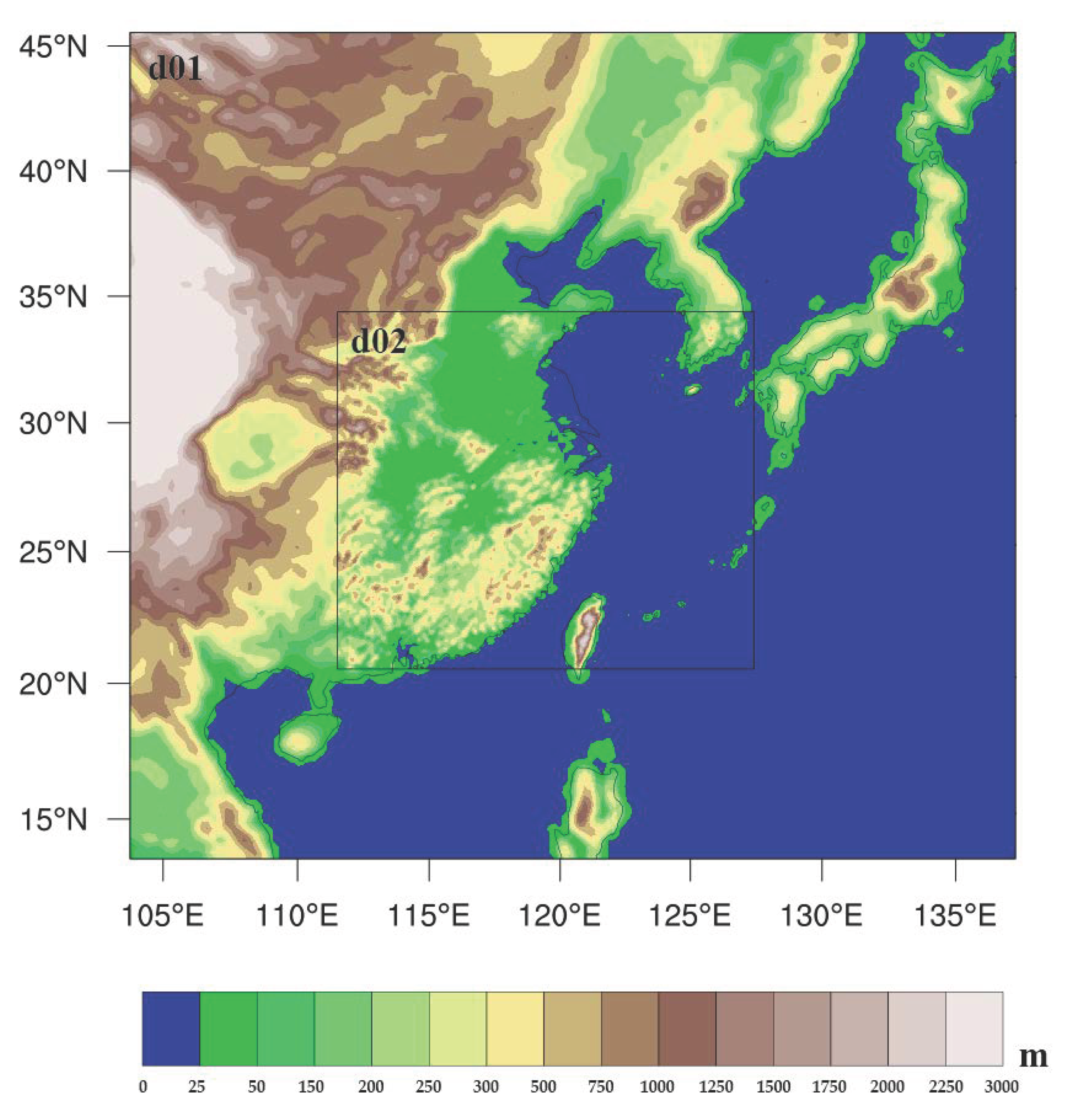
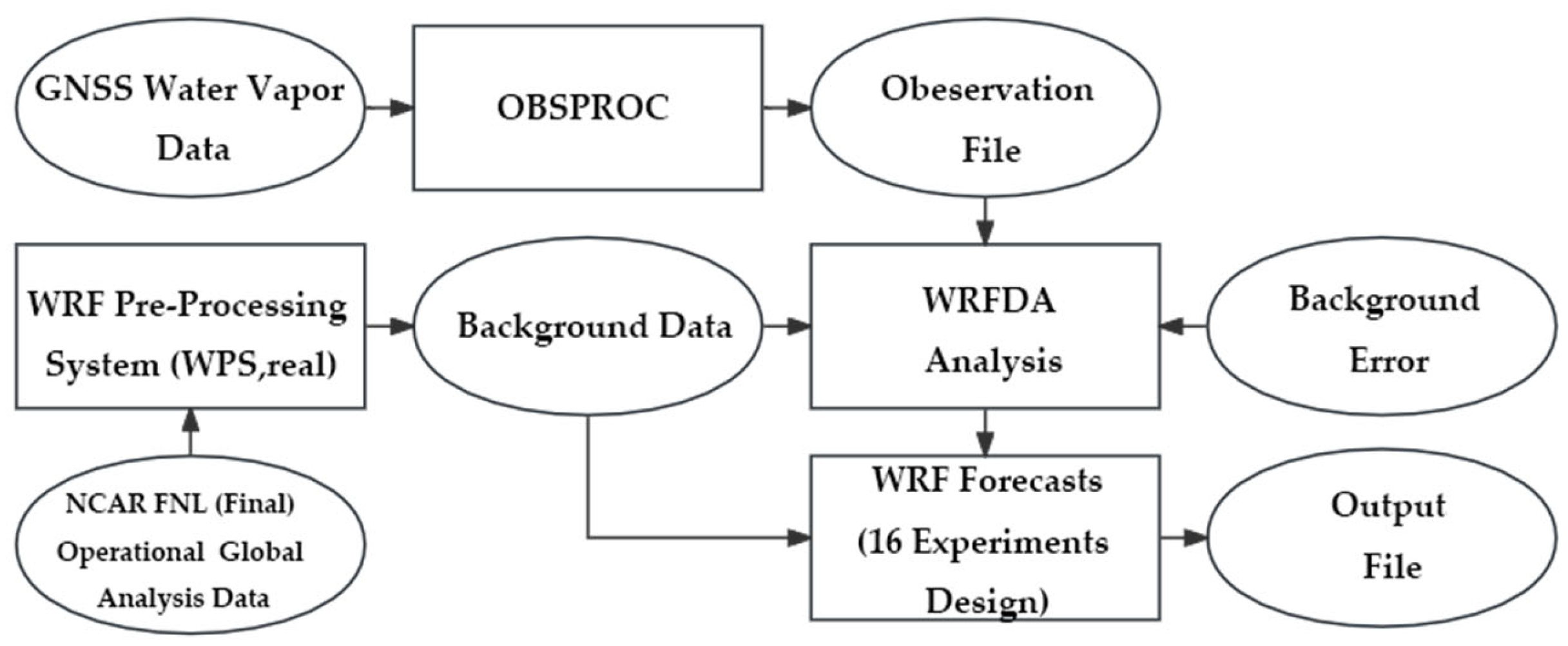



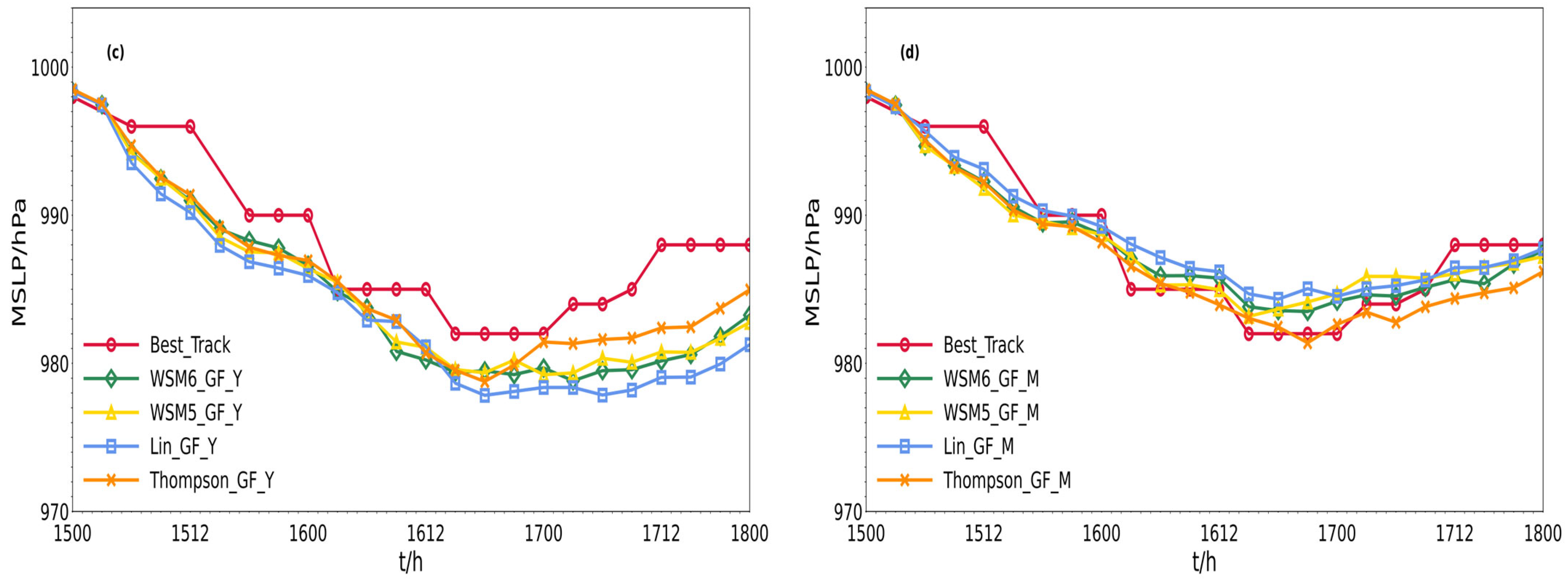
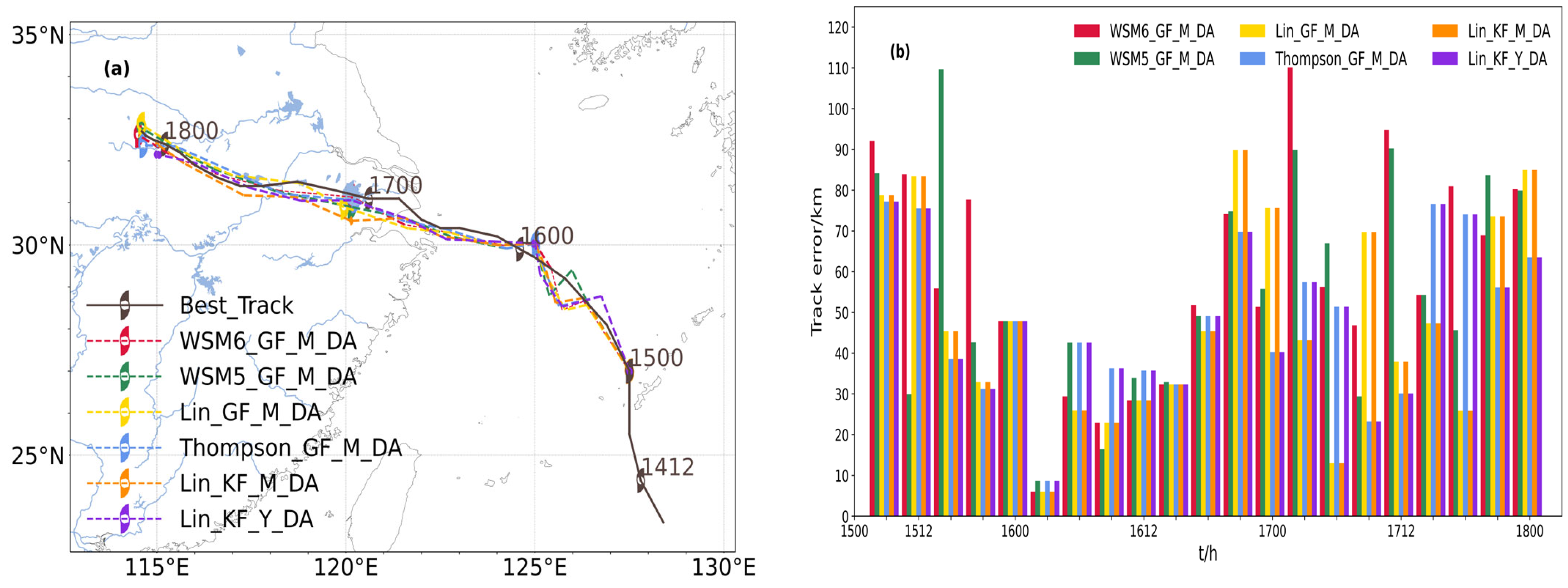
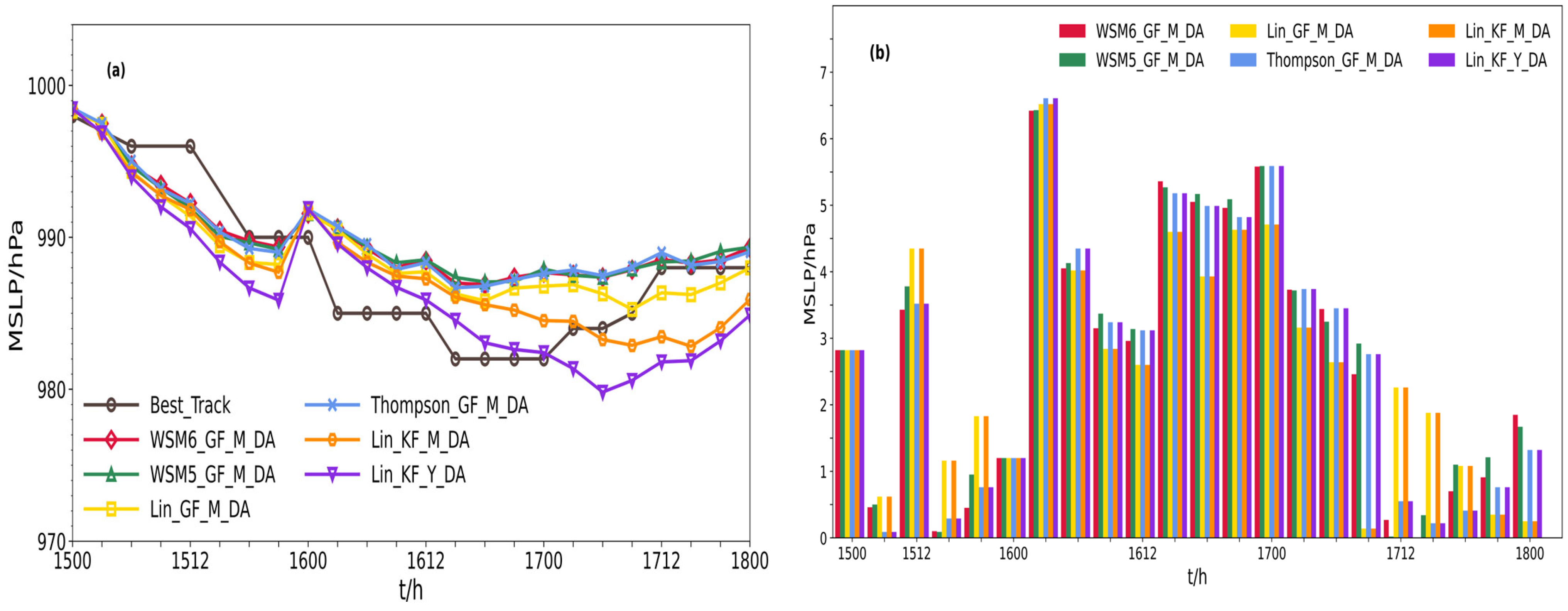
| WRF Model | Configurations |
|---|---|
| WRF Version | WRF 4.4.1 |
| Horizontal resolution/km | 27:9 |
| Mode integration time/h | 72 |
| Microphysical scheme | WSM6, WSM5, Lin, Thompson |
| Cumulus convection scheme | Kain-Fritsch (KF), Grell-Freitas (GF) |
| Boundary layer scheme | YSU (Y), MYJ (M) |
| Long wave radiation scheme | RRTM |
| Short wave radiation scheme | Dudhia |
| Land layer scheme | Noah |
| Group No. | Name | Microphysics | Cumulus | Boundary Layer |
|---|---|---|---|---|
| 1 | WSM6_KF_Y | WSM6 | Kain-Fritsch | YSU |
| 2 | WSM5_KF_Y | WSM5 | Kain-Fritsch | YSU |
| 3 | Lin_KF_Y | Lin | Kain-Fritsch | YSU |
| 4 | Thompson_KF_Y | Thompson | Kain-Fritsch | YSU |
| 5 | WSM6_KF_M | WSM6 | Kain-Fritsch | MYJ |
| 6 | WSM5_KF_M | WSM5 | Kain-Fritsch | MYJ |
| 7 | Lin_KF_M | Lin | Kain-Fritsch | MYJ |
| 8 | Thompson_KF_M | Thompson | Kain-Fritsch | MYJ |
| 9 | WSM6_GF_Y | WSM6 | Grell-Freitas | YSU |
| 10 | WSM5_GF_Y | WSM5 | Grell-Freitas | YSU |
| 11 | Lin_GF_Y | Lin | Grell-Freitas | YSU |
| 12 | Thompson_GF_Y | Thompson | Grell-Freitas | YSU |
| 13 | WSM6_GF_M | WSM6 | Grell-Freitas | MYJ |
| 14 | WSM5_GF_M | WSM5 | Grell-Freitas | MYJ |
| 15 | Lin_GF_M | Lin | Grell-Freitas | MYJ |
| 16 | Thompson_GF_M | Thompson | Grell-Freitas | MYJ |
| Name | 0–24 h | 24–48 h | 48–72 h | 0–72 h |
|---|---|---|---|---|
| WSM6_KF_Y | 50.45 | 72.49 | 211.69 | 117.10 |
| WSM5_KF_Y | 52.41 | 71.11 | 207.68 | 115.67 |
| Lin_KF_Y | 49.18 | 61.38 | 189.74 | 104.73 |
| Thompson_KF_Y | 55.77 | 69.96 | 234.82 | 126.04 |
| WSM6_KF_M | 52.39 | 72.69 | 240.03 | 128.01 |
| WSM5_KF_M | 53.70 | 70.96 | 221.11 | 120.85 |
| Lin_KF_M | 53.75 | 69.24 | 223.64 | 121.16 |
| Thompson_KF_M | 56.27 | 73.91 | 242.14 | 130.27 |
| WSM6_GF_Y | 70.03 | 129.73 | 238.55 | 153.02 |
| WSM5_GF_Y | 57.07 | 154.42 | 270.27 | 170.00 |
| Lin_GF_Y | 56.01 | 129.23 | 228.52 | 145.37 |
| Thompson_GF_Y | 51.65 | 116.40 | 247.37 | 146.37 |
| WSM6_GF_M | 56.06 | 102.83 | 181.85 | 118.81 |
| WSM5_GF_M | 53.26 | 83.45 | 165.30 | 104.98 |
| Lin_GF_M | 55.76 | 83.17 | 228.55 | 128.56 |
| Thompson_GF_M | 40.90 | 90.12 | 182.66 | 110.35 |
| Name | 0–24 h | 24–48 h | 48–72 h | 0–72 h |
|---|---|---|---|---|
| WSM6_KF_Y | 3.14 | 7.09 | 11.15 | 7.49 |
| WSM5_KF_Y | 3.10 | 6.50 | 10.87 | 7.16 |
| Lin_KF_Y | 3.35 | 5.47 | 9.63 | 6.41 |
| Thompson_KF_Y | 2.95 | 6.95 | 11.20 | 7.40 |
| WSM6_KF_M | 2.16 | 2.16 | 7.80 | 4.22 |
| WSM5_KF_M | 2.19 | 2.25 | 6.77 | 3.87 |
| Lin_KF_M | 2.35 | 2.83 | 7.40 | 4.36 |
| Thompson_KF_M | 2.24 | 3.75 | 9.67 | 5.49 |
| WSM6_GF_Y | 2.28 | 2.59 | 5.81 | 3.68 |
| WSM5_GF_Y | 2.55 | 2.22 | 5.51 | 3.51 |
| Lin_GF_Y | 3.20 | 2.56 | 7.21 | 4.42 |
| Thompson_GF_Y | 2.32 | 1.94 | 3.78 | 2.71 |
| WSM6_GF_M | 1.46 | 1.64 | 1.13 | 1.41 |
| WSM5_GF_M | 1.61 | 1.40 | 1.42 | 1.46 |
| Lin_GF_M | 1.89 | 2.37 | 1.11 | 1.78 |
| Thompson_GF_M | 1.40 | 0.64 | 2.06 | 1.36 |
| Name | 0–24 h | 24–48 h | 48–72 h | 0–72 h | ||||
|---|---|---|---|---|---|---|---|---|
| Before | After | Before | After | Before | After | Before | After | |
| WSM6_GF_M_DA | 56.06 | 59.55 (−6%) | 102.83 | 37.02 (64%) | 181.85 | 74.03 (59%) | 118.81 | 56.62 (52%) |
| WSM5_GF_M_DA | 53.26 | 52.36 (2%) | 83.45 | 39.27 (53%) | 165.30 | 67.47 (59%) | 104.98 | 53.10 (49%) |
| Lin_GF_M_DA | 55.76 | 48.05 (14%) | 83.17 | 40.79 (51%) | 228.55 | 49.43 (78%) | 128.56 | 45.91 (64%) |
| Thompson_GF_M_DA | 40.90 | 45.05 (−10%) | 90.12 | 39.35 (56%) | 182.66 | 54.04 (70%) | 110.35 | 46.25 (58%) |
| Lin_KF_M_DA | 53.75 | 50.76 (6%) | 69.24 | 43.84 (37%) | 223.64 | 29.76 (87%) | 121.16 | 40.60 (66%) |
| Lin_KF_Y_DA | 49.18 | 49.28 (0%) | 61.38 | 32.17 (48%) | 189.74 | 28.03 (85%) | 104.73 | 35.33 (66%) |
| Name | 0–24 h | 24–48 h | 48–72 h | 0–72 h | ||||
|---|---|---|---|---|---|---|---|---|
| Before | After | Before | After | Before | After | Before | After | |
| WSM6_GF_M_DA | 1.46 | 1.41 (3%) | 1.64 | 4.69 (−186%) | 1.13 | 1.67 (−48%) | 1.41 | 2.70 (−91%) |
| WSM5_GF_M_DA | 1.61 | 1.56 (3%) | 1.4 | 4.77 (−241%) | 1.42 | 1.78 (−25%) | 1.46 | 2.81 (−92%) |
| Lin_GF_M_DA | 1.89 | 2.00 (−6%) | 2.37 | 4.23 (−78%) | 1.11 | 1.47 (−32%) | 1.78 | 2.62 (−47%) |
| Thompson_GF_M_DA | 1.40 | 1.45 (-3%) | 0.64 | 4.74 (−641%) | 2.06 | 1.65 (20%) | 1.36 | 2.72 (−100%) |
| Lin_KF_M_DA | 2.35 | 2.04 (13%) | 2.83 | 3.48 (−23%) | 7.40 | 2.72 (63%) | 4.36 | 2.81 (36%) |
| Lin_KF_Y_DA | 3.35 | 2.75 (18%) | 5.47 | 2.34 (57%) | 9.36 | 4.44 (53%) | 6.41 | 3.22 (50%) |
Disclaimer/Publisher’s Note: The statements, opinions and data contained in all publications are solely those of the individual author(s) and contributor(s) and not of MDPI and/or the editor(s). MDPI and/or the editor(s) disclaim responsibility for any injury to people or property resulting from any ideas, methods, instructions or products referred to in the content. |
© 2024 by the authors. Licensee MDPI, Basel, Switzerland. This article is an open access article distributed under the terms and conditions of the Creative Commons Attribution (CC BY) license (https://creativecommons.org/licenses/by/4.0/).
Share and Cite
Li, L.; Ma, Y.; Li, K.; Pan, J.; Zhang, M. The WRF Simulation Influence of Assimilating GNSS Water Vapor and Parameterization Schemes on Typhoon Rumbia. Atmosphere 2024, 15, 255. https://doi.org/10.3390/atmos15030255
Li L, Ma Y, Li K, Pan J, Zhang M. The WRF Simulation Influence of Assimilating GNSS Water Vapor and Parameterization Schemes on Typhoon Rumbia. Atmosphere. 2024; 15(3):255. https://doi.org/10.3390/atmos15030255
Chicago/Turabian StyleLi, Li, Yixiang Ma, Kai Li, Jianping Pan, and Mingsong Zhang. 2024. "The WRF Simulation Influence of Assimilating GNSS Water Vapor and Parameterization Schemes on Typhoon Rumbia" Atmosphere 15, no. 3: 255. https://doi.org/10.3390/atmos15030255






